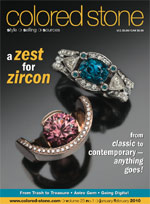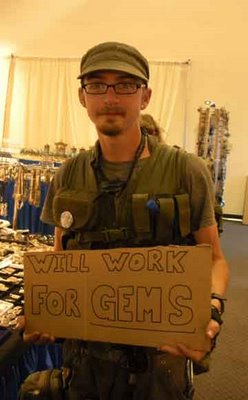by Richard W. Wise, G.G. © 2010
After 22 years Colored Stone Magazine has ceased publication. Other than a letter addressed to advertisers and signed by V.P. David Pyle, the parent company, Aspire Media, publicly known as Interweave Press, there has been little by way of an epitaph. The website is still up. Subscribers who have recently signed up have been told that they will be provided with an alternate subscription. The website is no longer accepting subscriptions requests.
With the demise several years ago of Gem Key, the loss of the 22 year old magazine leaves only two publications, one a relative new comer, In Color, published by The International Colored Stone Association and Gem Market News, another quarterly published by The Guide, covering the colored gemstone industry.
Founded in 1987 by the Gilbert family as a quarterly industry news magazine, Colored Stone has been through several incarnations. Its current owner, Interweave Press, is its third. As the name suggests, the parent company is most involved in publishing consumer oriented fiber arts magazines.
What brought the magazine to its end? According to Pyle’s letter it was all about the current economic situation. “The corporation was definitely profit driven” said Morgan Beard the former editor in chief. Beard who ran the magazine for 10 years, notes that “Colored Stone never really made money. The Tucson Show Guide kept the magazine afloat.” At its peak, the circulation was between 8-10,000, “sometimes”, she said, “we broke even.”
“Sorry to see it go”, said dealer Bear Williams summarizing industry reaction. “Yes, it’s too bad”, said Simon Watt (Mayer & Watt), but Watt goes on to make the broader point that: “we never have had any sort of real industry journalism.”
Many readers will recall Colored Stone’s controversial coverage of the so-called “Copper Diffusion” issue by then Editor-in-chief David Federman. Federman wrote several articles based unsupported claims by the proprietor of an unaccredited online gemological school concerning copper diffusion treatment of tourmaline, garnet and topaz. “Federman was on the right track with his coverage of enhancement issues”, but, on the James issue, “I called and told him, ‘“David you have lost perspective, he hung up on me.”’ “David Federman is a great writer but a lousy editor.” said Watt. Beard agrees, “Federman wrote what he believed but often did not investigate or take a balanced approach”, she said. Eventually the claims were determined to be faulty by Colored Stone’s own Science Editor among many others.
Federman’s coverage also resulted in a lawsuit by the Direct Shopping Network (DSN) that named Colored Stone and Interweave Press as defendants. Did the controversy contribute to Interweave’s decision to pull the plug on Colored Stone? Beard doubts it. “Interweave just shut down three of its magazines. I think they finally decided, we have the Show Guide making money and the magazine not, so why continue the magazine?” she speculated. Another source told me that an outside executive had been brought in to reorganize the magazine.
Another Interweave publication, the venerable Lapidary Journal/Jewelry Artist may be asked to step up and fill in the gap caused by the demise of her sister publication. Originally called just Lapidary Journal, the 60 year old magazine changed its focus just two years ago and directed its coverage more toward jewelry, but since October has begun repositioning itself back into the gem world said Merle White, Editor-in-Chief. When asked if this meant that her magazine would pick up the slack left by Colored Stone, “that has not been discussed”, she said. “We strengthened our gem coverage because our readers asked for it” she stated. Federman was terminated but Managing Editor, Karla Rosenbusch has been retained to coordinate The Tucson Show Guide. What will be the fate of Colored Stone’s online newsletter Gem-Mail? “That is under discussion” said White.
Countdown To Tucson 2010
The major industry extravaganza known as The Tucson Gem Shows are just a couple of weeks away. This will be my 25th year and my wife Rebekah and I will spend a full two weeks at the shows.
I predict that it will be all about price this year. The gem and jewelry industry is being squeezed from both ends. As Wayne Prentise of Troy Diamond Report points out: “for 2009 three currencies tracked gained over 20% in real value: Australian Dollar +27.72%, Brazilian Real +24.99%, New Zealand Dollar +21.81 …while Gold increased +28.2%, all when measured to the basket of currencies.” Prentise predicts higher prices for Brazilian and Austrailian gems at Tucson this year. By contrast, David Stanley Epstein, an American dealer living in Brazil recently reported substantial decreases in the prices of Brazilian gem being offered in the Brazil’s gem capital of Teofilo Otoni.
Where does the truth lie? Stay tuned for the true gem. I will be posting regular reports from Tucson on GemWise beginning February 1st.


